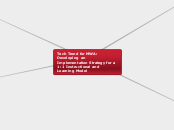av Damon Edwards 10 år siden
272
Tech Trend for MWA: 1:1 Initiative
The process of developing a 1:1 instructional and learning model involves creating a shared vision among key stakeholders and meticulous planning. Initially, stakeholders such as parents, students, staff, faculty, administrators, and board members collaborate to form a cohesive vision for the new model.









